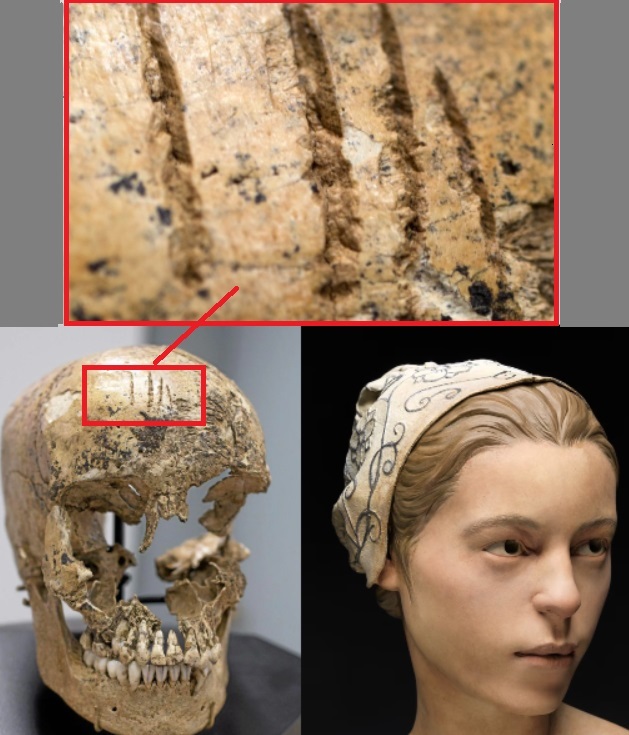In the murky wetlands of 17th-century Jamestown, Virginia, archaeologists uncovered a deeply unsettling chapter in American colonial history—one that offers a haunting glimpse into the extreme hardships faced by the first English settlers. Among the artifacts and remnants of early life in the colony, a particularly chilling discovery emerged: the skeletal remains of a 14-year-old girl, later referred to only as “Jane.” Her bones bore unmistakable signs of postmortem dismemberment and cannibalism—grim evidence of the desperation that had descended upon the settlers during the brutal winter of 1609 to 1610, a time forever marked in history as the “starving time.”

During this period, Jamestown was gripped by severe drought and a catastrophic shortage of food. Crops withered under the unrelenting sun, wild game became scarce, and even the swampy waters surrounding the colony yielded fewer fish and shellfish than usual. The settlers, many of whom were unaccustomed to the rugged demands of survival in the New World, struggled to adapt. Relations with the local Powhatan Confederacy had deteriorated significantly, leading to violent confrontations and a breakdown in trade. With hostilities rising, the settlers found themselves besieged inside the wooden walls of their fort, cut off from potential food sources and outside assistance.
It was within this grim context that Jane’s tragic story unfolded. Her bones were unearthed from a cellar within the fort’s perimeter—likely a storage space that had been hastily converted into a makeshift burial ground. The forensic team, led by Douglas Owsley, a renowned physical anthropologist with the Smithsonian Institution, carefully examined the remains and identified the distinctive marks left behind by knives and cleavers. These were not the precise incisions of experienced butchers. Instead, they were hesitant, irregular cuts—marks that revealed both inexperience and deep emotional conflict. It was clear that whoever had performed the act was not only untrained but also likely operating under extreme psychological and physical duress.
Jane’s skull bore shallow cuts on the forehead, indicative of the initial attempts to access the brain, one of the last remaining sources of nutrition in a body. Further evidence of scraping and prying around the jawbone and cheek area suggested that flesh had been removed in a methodical yet clumsy fashion. There was also damage to the tibia and femur, consistent with efforts to extract marrow, a nutrient-rich substance valued in survival scenarios. The pattern of dismemberment and defleshing left little doubt—this was an act of cannibalism, born not of cruelty but of unimaginable hunger.
What sets Jane’s case apart from folklore or anecdotal records is the meticulous scientific analysis that supports the findings. Her remains represent the first physical evidence of cannibalism at Jamestown, confirming historical accounts that had long been considered hearsay or exaggerated rumor. According to period writings, colonists during the starving time resorted to eating dogs, cats, rats, leather from their boots, and, ultimately, the flesh of those who had died. These accounts were often dismissed or downplayed over the centuries, but Jane’s remains provide chilling validation of their accuracy.
Yet, amid the horror of her fate lies a compelling human story—one of endurance, resilience, and the will to survive. Jane’s life before arriving in the New World is a mystery. Isotopic analysis of her bones suggests she was from southern England and had a diet typical of lower-status families, rich in grains and vegetables but low in protein. She may have come to Jamestown with her family in search of a better future or as a servant bound to a household. Regardless of her origins, her death—and what happened to her body afterward—speaks volumes about the social and physical collapse that overtook the colony during its darkest days.
The recreation of Jane’s face, based on her skull structure, brings her story even closer to us. With modern technology, forensic artists were able to craft a life-like image of the teenage girl, giving her a presence that history had all but erased. Her eyes, expression, and youth are arresting reminders that behind every archaeological discovery lies a real person with hopes, fears, and a story that deserves to be told. She was not just a set of bones but a young girl whose brief life intersected with one of the most brutal chapters of colonial America.
Jane’s reconstructed face has been placed on display at Jamestown’s archaeological museum, serving as a symbol of the sacrifices endured by early settlers and the harsh conditions that defined their existence. Her story stands not as a tale of horror, but as a sober lesson in history—highlighting the resilience of the human spirit and the extreme conditions that shaped the beginnings of what would eventually become the United States.
As modern visitors walk the grounds of historic Jamestown, surrounded by reconstructed buildings, museum exhibits, and interpretive guides, Jane’s presence lingers. Her story forces us to look beyond romanticized notions of colonial courage and examine the raw, often uncomfortable truths about survival and human nature. In acknowledging the depth of the colonists’ suffering, we also honor their strength and determination. Jane, though nameless in the records of time, has given voice to an entire generation of forgotten settlers who endured starvation, isolation, and fear with little more than grit and hope.
In the end, Jane’s legacy is not just one of tragedy but of remembrance. Her remains tell a story that written history dared not fully confront—until now. Through the lens of science and the dedication of archaeologists and anthropologists, we are finally able to bear witness to her experience. She reminds us that history is not made solely by the victors or the powerful but by every soul who walked its path—no matter how brief or how quiet their journey may have been.





